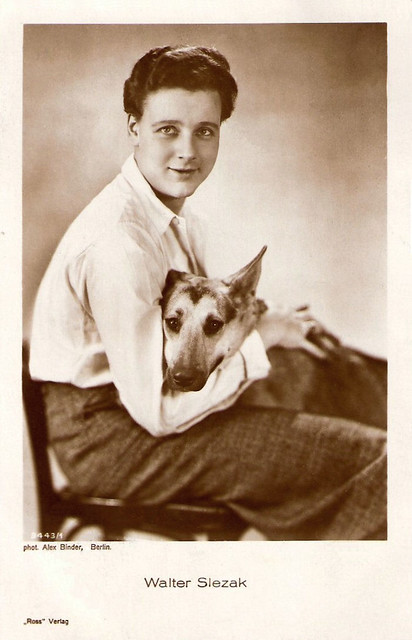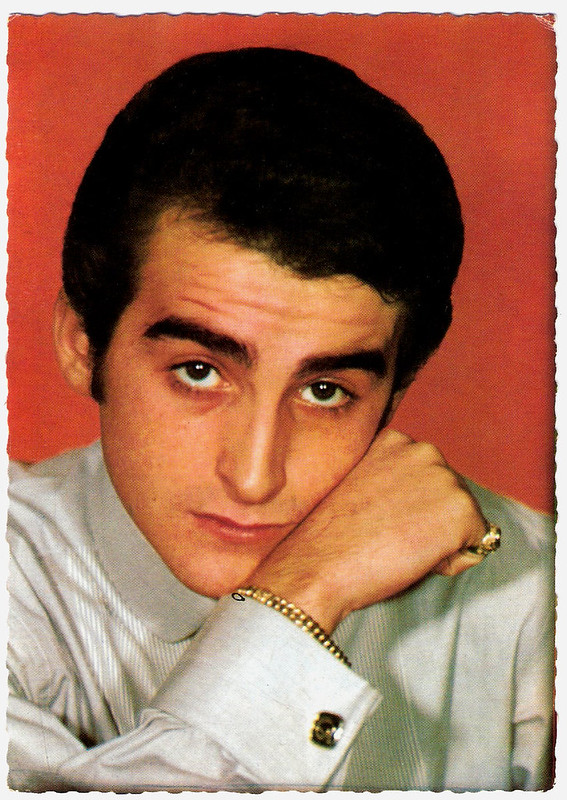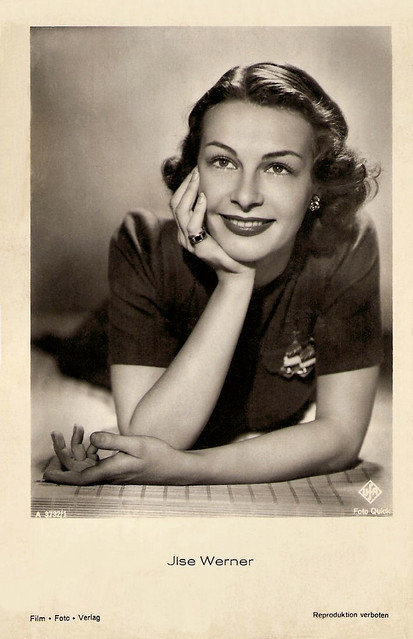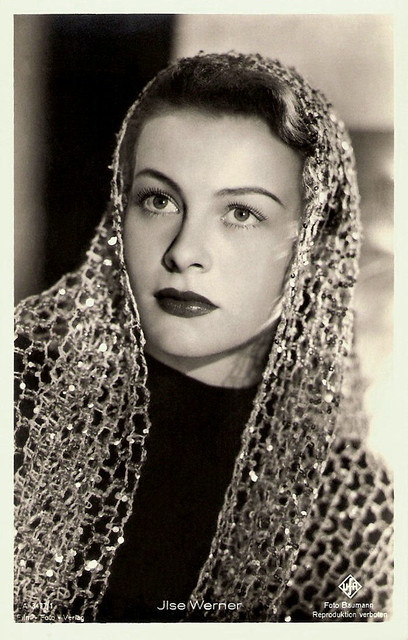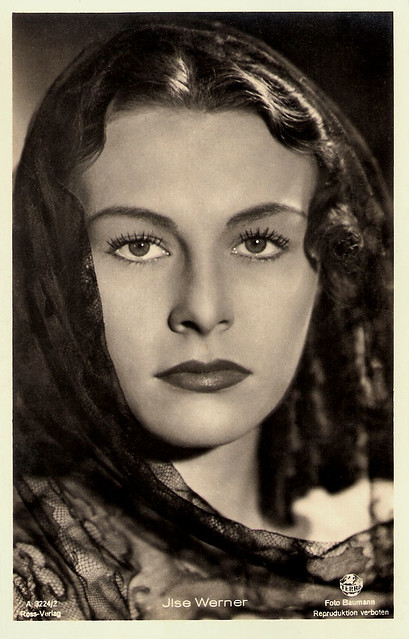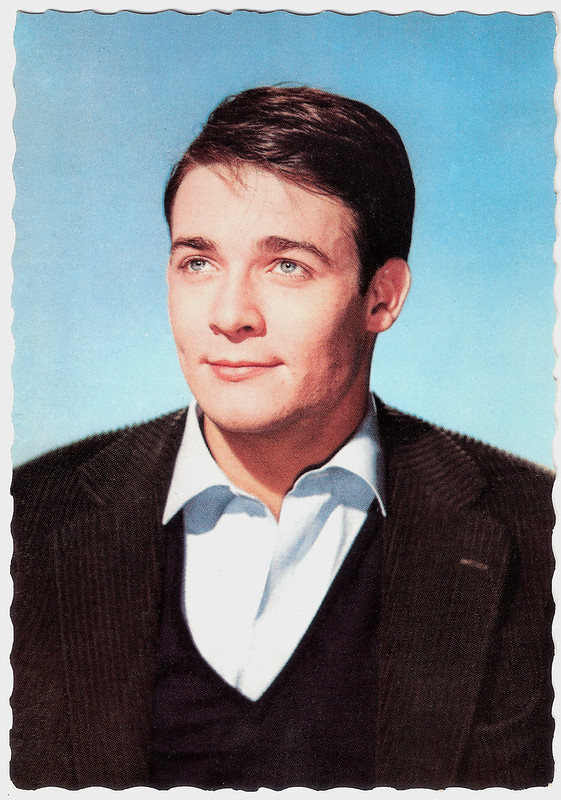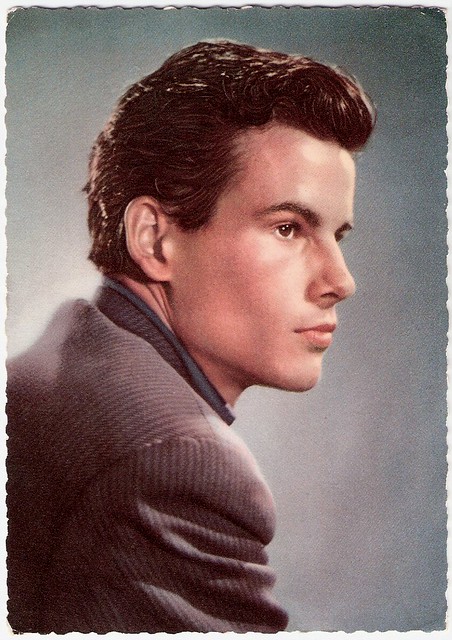For Jan.
Jewish cabaret artist Valeska Gert (1892-1978) became famous in Berlin with her radical modern dances. With her dark, aquiline features. she was also active as an artists' model and appeared in several classics of the Weimar Cinema. After a comeback in Fellini’s Giulietta degli spiriti/Juliet of the Spirits (1965), Gert worked with the film makers of the New German Cinema of the 1970s.
![Valeska Gert]()
German card. Photo: Atelier Leopold, München (Munich). Collection: Didier Hanson.
Valeska Gert was born as Gertrud Valesca Samosch in 1892 in Berlin to a Jewish family. She was the eldest daughter of manufacturer Theodor Samosch and Augusta Rosenthal.
Exhibiting no interest in academics or office work, Gert began taking dance lessons at the age of nine. This, combined with her love of ornate fashion, was the basis for her career in dance and performance art.
In 1915, she studied acting with Maria Moissi.
World War I had a negative effect on her father’s finances, forcing Gert to rely on herself far more than other bourgeois daughters typically might. As World War I raged on, Gert joined a Berliner dance group and created revolutionary satirical dance.
In 1916, Gert made her dance debut in a Berlin film house, performing between film reels. The same year, she began acting at the Munich Kammerspiele.
Following engagements at the Deutsches Theater and the Tribüne in Berlin, Gert was invited to perform in expressionist plays in Dadaist mixed media art nights. Her performances in Oskar Kokoschka’s Hiob (1918), Ernst Toller’s Transformation (1919), and Frank Wedekind’s Franziska earned her popularity.
During this time, she also performed in the Schall und Rauch cabaret. Gert launched a tour of her own dances, with titles like Dance in Orange, Boxing, Circus, Japanese Grotesque, Death, and Whore. With her highly athletic style of dance, she created a sensation.
She also contributed articles for magazines like Die Weltbühne and the Berliner Tageszeitung.
![Valeska Gert]()
German card. Collection: Didier Hanson.
By 1923, Valeska Gert focused her work more on film acting than live performance.
She played Puck in the Ufa production Ein Sommernachtstraum/Wood Love (Hans Neumann, 1925). This adaptation of William Shakespeare's A Midsummer Night's Dream had an all-star cast including Werner Krauss, Alexander Granach en Hans Albers.
In 1925 she also appeared in the classic Die freudlose Gasse/Joyless Street (G. W. Pabst, 1925), starring Asta Nielsen and the young Greta Garbo in her second major role.
Craig Butler at AllMovie: “Street is not about any one person but about a time, a place and, above all, a society that was perilously divided into two very unequal parts. Director G.W. Pabst and scenarist Willy Haas have created a social conscience melodrama that is enormously powerful; it's manipulative at times, but there's such commitment behind it that most viewers won't mind. Pabst is excellent at exploring the bleakness and despair of the residents of the Street and contrasting it with the amorality and immorality of the upper classes, who think nothing of spreading false rumors that will destroy many but will increase their own already considerable wealth.”
Gert also performed in G. W. Pabst’s Tagebuch einer Verlorenen/Diary of a Lost Girl (G. W. Pabst, 1929), and Die 3-Groschen-Oper/The Threepenny Opera (G. W. Pabst, 1931), loosely based on the 1928 musical theatre success The Threepenny Opera by Bertolt Brecht and Kurt Weill.
Gert played Mrs. Peachum, and according to Hal Erickson at AllMovie the film version “is every bit as good as the stage original, and sometimes even better.”
In France she appeared in Jean Renoir’s second film Nana (1926), a lavishly appointed adaptation of Emile Zola's novel. Other classic silent films with her were the science fiction horror film Alraune/Mandrake (Henrik Galeen, 1928) featuring Brigitte Helm, and Menschen am Sonntag/People on Sunday (Robert Siodmak, Rochus Gliese, Edgar G. Ulmer, 1930), based on a screenplay by Billy Wilder.
In the late twenties, Gert returned to the stage with pieces emphasizing Tontänze (sound dances), which explored the relationship between movement and sound.
![Valeska Gert, 1918]()
German card. Photo: Atelier Leopold, München (Munich). Collection: Didier Hanson.
In 1933, Valeska Gert’s Jewish heritage resulted in her ban from the German stage. Her exile from performance in Germany sent her to London for some time, where she worked both in theatre and film.
In London she worked on the experimental short film Pett and Pot (Alberto Cavalcanti, 1934), which would long stand as her last film.
In 1936, Gert wed an English writer, Robin Hay Anderson. It was her second marriage and her first husband had been Helmuth von Krause.
In 1938, she emigrated to the United States, where it was difficult for her to continue her previous career. She lived on the welfare of a Jewish refugee community and found work washing dishes and sometimes posing as a nude model.
This same year, she hired the 17-year old Georg Kreisler as a rehearsal pianist to continue focus on cabaret work.
By 1941, she had opened the Beggar Bar in New York, where Julian Beck, Judith Malina, and Jackson Pollock worked for her. Tennessee Williams also worked for her for a short time as a busboy, but was fired for refusing to pool his tips.
By 1944, Gert had relocated to Provincetown, Massachusetts, where she opened Valeska's. During this period, Gert was called to Provincetown court for throwing garbage out of her window and failing to pay a dance partner. She called upon Williams as a character witness, which he did with pleasure, despite the fact that she fired him. He told incredulous friends that he "simply liked her".
![Asta Nielsen]()
Asta Nielsen. German postcard by Ross Verlag, no. 1140/1, 1927-1928. Photo: Alex Binder, Berlin.
![Brigitte Helm]()
Brigitte Helm. German postcard by Ross Verlag, no. 5501/2, 1930-1931. Photo: Ufa. Distributed in Italy by Ballerini& Frattini, Florence.
In 1947 Valeska Gert returned to Europe. After stays in Paris and Zurich, she went to Blockaded Berlin in 1949, where she opened the cabaret Hexenküche (Witch's Kitchen) in the next year. Following Hexenküche, she opened Ziegenstall on the island of Sylt.
In the 1960s, she made her screen comeback. She was rediscovered by Federico Fellini who gave her a part in his film Giulietta degli spiriti/Juliet of the Spirits (1965), featuring Giulietta Masina.
The film brought her to the attention of a new generation of German directors. During the 1970s, she played in an episode of Rainer Werner Fassbinder's serial Acht Stunden sind kein Tag/Eight Hours are Not a Day (1973), the experimental film Die Betörung der blauen Matrosen/The Enchantment of the Blue Sailors (Tabea Blumenschein, Ulrike Ottinger, 1975) and in Volker Schlöndorff's Der Fangschuss/Coup de grâce (1976), with Matthias Habich.
Schlöndorff also made a documentary about her, Nur zum Spaß, nur zum/Just for fun, just for the game (1977). Gert told in this film about theatre in Berlin in the 1920s, and her dances were re-created by Pola Kinski.
In 1978 Werner Herzog invited Gert to play the real estate broker Knock in his remake of F.W. Murnau's classic film Nosferatu, but she died just two weeks later before filming began.
On 18 March 1978 neighbours and friends in Kampen, Germany, reported she had not been seen for four days. When her door was forced in the presence of police she was found dead. She was 86 years old.
In 1970. she had been awarded with the Filmband in Gold for lifelong achievement in German film.
Valeska Gert’s art was for the first time exhibited in 2010 in the Berlin Museum for Contemporary Art Hamburger Bahnhof.
Valeska Gert - Die Frau im Taumel des Lasters. Short scene from the documentary Cabaret Berlin - Die wilde Bühne 1919 - 1933. Source: dict adtv (YouTube)
Scene from Der Fangschuss/Coup de grâce (1976). Source: Matcarriere (YouTube).
Sources: Thomas Staedeli (Cyranos), Craig Butler (AllMovie), Hal Erickson (AllMovie), Wikipedia and IMDb.
Jewish cabaret artist Valeska Gert (1892-1978) became famous in Berlin with her radical modern dances. With her dark, aquiline features. she was also active as an artists' model and appeared in several classics of the Weimar Cinema. After a comeback in Fellini’s Giulietta degli spiriti/Juliet of the Spirits (1965), Gert worked with the film makers of the New German Cinema of the 1970s.

German card. Photo: Atelier Leopold, München (Munich). Collection: Didier Hanson.
Dadaist Mixed Media Art Nights
Valeska Gert was born as Gertrud Valesca Samosch in 1892 in Berlin to a Jewish family. She was the eldest daughter of manufacturer Theodor Samosch and Augusta Rosenthal.
Exhibiting no interest in academics or office work, Gert began taking dance lessons at the age of nine. This, combined with her love of ornate fashion, was the basis for her career in dance and performance art.
In 1915, she studied acting with Maria Moissi.
World War I had a negative effect on her father’s finances, forcing Gert to rely on herself far more than other bourgeois daughters typically might. As World War I raged on, Gert joined a Berliner dance group and created revolutionary satirical dance.
In 1916, Gert made her dance debut in a Berlin film house, performing between film reels. The same year, she began acting at the Munich Kammerspiele.
Following engagements at the Deutsches Theater and the Tribüne in Berlin, Gert was invited to perform in expressionist plays in Dadaist mixed media art nights. Her performances in Oskar Kokoschka’s Hiob (1918), Ernst Toller’s Transformation (1919), and Frank Wedekind’s Franziska earned her popularity.
During this time, she also performed in the Schall und Rauch cabaret. Gert launched a tour of her own dances, with titles like Dance in Orange, Boxing, Circus, Japanese Grotesque, Death, and Whore. With her highly athletic style of dance, she created a sensation.
She also contributed articles for magazines like Die Weltbühne and the Berliner Tageszeitung.

German card. Collection: Didier Hanson.
A Social Conscience Melodrama
By 1923, Valeska Gert focused her work more on film acting than live performance.
She played Puck in the Ufa production Ein Sommernachtstraum/Wood Love (Hans Neumann, 1925). This adaptation of William Shakespeare's A Midsummer Night's Dream had an all-star cast including Werner Krauss, Alexander Granach en Hans Albers.
In 1925 she also appeared in the classic Die freudlose Gasse/Joyless Street (G. W. Pabst, 1925), starring Asta Nielsen and the young Greta Garbo in her second major role.
Craig Butler at AllMovie: “Street is not about any one person but about a time, a place and, above all, a society that was perilously divided into two very unequal parts. Director G.W. Pabst and scenarist Willy Haas have created a social conscience melodrama that is enormously powerful; it's manipulative at times, but there's such commitment behind it that most viewers won't mind. Pabst is excellent at exploring the bleakness and despair of the residents of the Street and contrasting it with the amorality and immorality of the upper classes, who think nothing of spreading false rumors that will destroy many but will increase their own already considerable wealth.”
Gert also performed in G. W. Pabst’s Tagebuch einer Verlorenen/Diary of a Lost Girl (G. W. Pabst, 1929), and Die 3-Groschen-Oper/The Threepenny Opera (G. W. Pabst, 1931), loosely based on the 1928 musical theatre success The Threepenny Opera by Bertolt Brecht and Kurt Weill.
Gert played Mrs. Peachum, and according to Hal Erickson at AllMovie the film version “is every bit as good as the stage original, and sometimes even better.”
In France she appeared in Jean Renoir’s second film Nana (1926), a lavishly appointed adaptation of Emile Zola's novel. Other classic silent films with her were the science fiction horror film Alraune/Mandrake (Henrik Galeen, 1928) featuring Brigitte Helm, and Menschen am Sonntag/People on Sunday (Robert Siodmak, Rochus Gliese, Edgar G. Ulmer, 1930), based on a screenplay by Billy Wilder.
In the late twenties, Gert returned to the stage with pieces emphasizing Tontänze (sound dances), which explored the relationship between movement and sound.

German card. Photo: Atelier Leopold, München (Munich). Collection: Didier Hanson.
Exile
In 1933, Valeska Gert’s Jewish heritage resulted in her ban from the German stage. Her exile from performance in Germany sent her to London for some time, where she worked both in theatre and film.
In London she worked on the experimental short film Pett and Pot (Alberto Cavalcanti, 1934), which would long stand as her last film.
In 1936, Gert wed an English writer, Robin Hay Anderson. It was her second marriage and her first husband had been Helmuth von Krause.
In 1938, she emigrated to the United States, where it was difficult for her to continue her previous career. She lived on the welfare of a Jewish refugee community and found work washing dishes and sometimes posing as a nude model.
This same year, she hired the 17-year old Georg Kreisler as a rehearsal pianist to continue focus on cabaret work.
By 1941, she had opened the Beggar Bar in New York, where Julian Beck, Judith Malina, and Jackson Pollock worked for her. Tennessee Williams also worked for her for a short time as a busboy, but was fired for refusing to pool his tips.
By 1944, Gert had relocated to Provincetown, Massachusetts, where she opened Valeska's. During this period, Gert was called to Provincetown court for throwing garbage out of her window and failing to pay a dance partner. She called upon Williams as a character witness, which he did with pleasure, despite the fact that she fired him. He told incredulous friends that he "simply liked her".

Asta Nielsen. German postcard by Ross Verlag, no. 1140/1, 1927-1928. Photo: Alex Binder, Berlin.

Brigitte Helm. German postcard by Ross Verlag, no. 5501/2, 1930-1931. Photo: Ufa. Distributed in Italy by Ballerini& Frattini, Florence.
Fellini and Fassbinder
In 1947 Valeska Gert returned to Europe. After stays in Paris and Zurich, she went to Blockaded Berlin in 1949, where she opened the cabaret Hexenküche (Witch's Kitchen) in the next year. Following Hexenküche, she opened Ziegenstall on the island of Sylt.
In the 1960s, she made her screen comeback. She was rediscovered by Federico Fellini who gave her a part in his film Giulietta degli spiriti/Juliet of the Spirits (1965), featuring Giulietta Masina.
The film brought her to the attention of a new generation of German directors. During the 1970s, she played in an episode of Rainer Werner Fassbinder's serial Acht Stunden sind kein Tag/Eight Hours are Not a Day (1973), the experimental film Die Betörung der blauen Matrosen/The Enchantment of the Blue Sailors (Tabea Blumenschein, Ulrike Ottinger, 1975) and in Volker Schlöndorff's Der Fangschuss/Coup de grâce (1976), with Matthias Habich.
Schlöndorff also made a documentary about her, Nur zum Spaß, nur zum/Just for fun, just for the game (1977). Gert told in this film about theatre in Berlin in the 1920s, and her dances were re-created by Pola Kinski.
In 1978 Werner Herzog invited Gert to play the real estate broker Knock in his remake of F.W. Murnau's classic film Nosferatu, but she died just two weeks later before filming began.
On 18 March 1978 neighbours and friends in Kampen, Germany, reported she had not been seen for four days. When her door was forced in the presence of police she was found dead. She was 86 years old.
In 1970. she had been awarded with the Filmband in Gold for lifelong achievement in German film.
Valeska Gert’s art was for the first time exhibited in 2010 in the Berlin Museum for Contemporary Art Hamburger Bahnhof.
Valeska Gert - Die Frau im Taumel des Lasters. Short scene from the documentary Cabaret Berlin - Die wilde Bühne 1919 - 1933. Source: dict adtv (YouTube)
Scene from Der Fangschuss/Coup de grâce (1976). Source: Matcarriere (YouTube).
Sources: Thomas Staedeli (Cyranos), Craig Butler (AllMovie), Hal Erickson (AllMovie), Wikipedia and IMDb.









